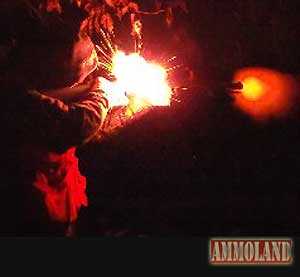By Hovey Smith


Central Georgia –-(Ammoland.com)- Those who are looking for a reasonably priced off-the-rack flintlock rifle to participate in Pennsylvania ’s and other states flintlock muzzleloading seasons/hunts can reasonably consider Traditions PA Pellet rifle as an effective alternative to higher-priced guns. Flintlocks made by Davide Pedersoli and sold by Dixie Gun Works and other companies now start at $600 and up with custom-made guns often selling for about $3,000 and up. Although the $400 black synthetic stocked PA Pellet rifle that I recently used on an Illinois deer hunt is not as attractive as its higher-priced alternatives, it is a reliable flintlock gun that performs well with either loose black powder or granular Pyrodex or Hodgdon’s Triple7even. As might be expected from its name, it will also shoot Pyrodex and Triple7even pellets if a little priming powder is teased back of the pellets when the pan is charged with FFFFg.

My first experiences with factory flintlock rifles began with Thompson/Center Arms’ Hawken which used the same coil-spring lock as their percussion gun. My gun had a warped pan cover that allowed prime to dribble from the pan if the gun was tilted to the right. Replacing the frizzen with a new one solved this problem, but an even greater problem was that the coil-spring-lock would not reliably spark. This problem also extended to the modernized Thompson/Center Arms’ Firestorm flintlock, which I experimented with for over a year. A partial solution was to reinforce the strength of the coil spring by putting one or two lock washers on the rod back of the lock’s mainspring. This helped, but flint life with these guns was short. For sure-fire results I had to use fresh flints and retouch them every few shots with a small knapping hammer. Gregg Ritts, then the CEO of Thompson/Center Arms told me, “This is just part of shooting flint.” Sorry Gregg, but good flint guns will shoot a half-dozen times or more before the flint has to be touched. While it is always good practice to start a hunt with a fresh flint, hunting guns need to shoot more reliably that that, and the new versions of the flintlocks used on Traditions’ PA hunter’s leaf-spring lock performs much better than the Thompson/Center coil-spring locks or the similar locks used on Lyman’s flintlocks. Although less expensively made than Thompson/Center’s guns, the plastic stocked Traditions PA Pellet rifle was more reliable than the two Thompson/Center Arms rifles or even the Lyman flintlock. When it comes to deer killing, functionality is much more important to me than appearance. My hunts with the PA Pellet rifle demonstrated that the gun could be used in snowy conditions and still function with either loose powders or Pyrodex or Triple7even pellets, provided that some reasonable precautions were taken.

In my new E-book Shooting and Maintaining Your Muzzleloader (Amazon.com https://tiny.cc/navpax) I have a chapter titled “Twenty-one steps to flintlock success,” and following are some shooting tips that particularly pertain to the PA Hunter.
1. Remove the butt plate from the rear of the stock and add lead shot or sand with wadded plastic bags to increase the weight of the gun until it balances about the carry point. This increased weight makes the gun much more comfortable to shoot and carry as well as decreases the chance of it slipping out of your lap as you sit in your tree stand.
2. Either you or a gunsmith should disassemble the lock and use a fine oil stone to polish any burrs from the lock parts that increase friction by scrubbing against the lock plate.
3. Have a gunsmith recess the crown of your barrel back about 3/8ths inch by drilling that portion of the barrel smooth so that saboted or lead bullets will be easier to load straight without damaging the bases of the projectiles. This is $20 very well spent.
4. Purchase cut-agate flints. These are available from Thompson/Center as four-packs ( https://tiny.cc/xvvpax ) . These are usually found on peg-board displays with other muzzleloading products.
5. Thompson Center also sells a ring of flintlock tools, including a pan brush and vent prick. These are worth having for cleaning your pan and brushing excess prime from the sides of the pan.
6. Buy or beg some FFFFg black powder priming powder. Hodgdon’s Triple7even FFFg granular powder ( https://tinyurl.com/khbnbn3 ) will sort of work, but gives slower ignition than black powder. At about 5-grains per prime, a one-pound can will last for more than 1,000 shots. Get two cans while you are at it. These will keep forever if kept dry, and you never can tell when our supply of black powder might be terminated by over-protective legislators.
7. Use a leather cover to help protect your lock from rain or snow. These are available from Dixie Gun Works. (Go ahead and purchase their catalogue for $5.00. It contains a wealth of information about muzzleloaders and black-powder guns.)
8. De-grease the barrel and lock before you shoot the gun for the first time and take a small bottle of rubbing alcohol with you in the field to clean the frizzen as needed.
9. The PA Pellet will shoot patched round balls (may be required for some hunts), saboted bullets or lead bullets. Saboted bullets will generate higher pressures and promote more complete combustion of the powder, although they are an SOB to load in cold weather. Carry your bullets and powder in plastic tubes or quick loaders on your body to keep them warm.
10. Select or grind some screwdrivers to fit the slots of the PA Pellet rifle’s screws and keep these with the gun.
11. You will need either a piece of leather or lead to pad the flint in the jaws of the cock. You can either pound a lead ball flat and or cut a piece of leather from a worn-out bag, shoe or belt.
12. Loads that work best in this gun will have from 85-110 grains of loose powder behind a patched round ball or 100 grains of Pyrodex or Triple7even pellets. Although this is a .50-caliber gun, it will shoot well with either .45 or .50 caliber pellets. I prefer bullets that weigh about 300 grains, although the gun does reasonably well with 240-grain saboted bullets or the 370-grain Thompson/Center MaxiBall.
13. After shooting I do not recommend attempting to remove the breech plug of this gun for ordinary cleaning, as the version that I have does not have an easy-removing plug. These may be used on some later production guns, but it is not present on mine.
14. Each time you get through using the gun, even if you fire only a single shot the barrel needs to be washed out with soapy water and dried. Each time you clean the gun screw out the vent plug and clean it. Its threads should be lubricated with a high-temperature grease. This is a small part and is easy to drop it down a sink drain.
15. Although the PA Pellet rifle has been in the Traditions line for a few years it is a low-volume seller and production might be stopped at any time. It is prudent to buy some spare parts that might be easily lost or damaged.
These should include.
- 1. Spare frizzen
- 2. Vent hole liner
- 3. Upper hammer jaw
- 4. Jaw screw (threads get stripped on this part)
- 5. Lock plate screw and washer
- 6. Barrel wedge
16. When shooting pellets, take your prick or the arm of a large safety pin and push about half-a-pans-worth of FFFFg prime into the back of the barrel. The priming pan should be a little more than half full, but not blocking the vent hole which should be opened. If it is packed full it will burn like a fuse and retard ignition.
17. Flintlocks (aka. flinchlocks) throw a bright ball of flame up in front of the master eye, and it is always best to shoot with the gun well braced against your body, a tree or something. Shoot from any sort of expedient field rest as might be available.
18. Practice with your gun. Shooting flint is something of an art where you learn that you must keep your powder level in the pan, pay attention to the weather, keep your lock dry, follow through after you pull the trigger and learn to master involuntary jerks as you shoot the gun.
19. Until you really feel confident with your gun, restrict your shots to about 50 yards. Well practiced flintlock shooters can make hits at any range, but beginners need to start short and then shoot long as they gain more experience.
I have several YouTube videos about this gun and hunting with it. These include one on the hunt at: https://youtu.be/iiIJy1cYHNI and another on developing loads for the rifle at: https://youtu.be/yIoiR9fyCzA. ‘ I was hunting with Bob White of Living Water in the Heartland who offers Illinois bow and gun hunting on several properties near Mt. Sterling in Brown County. He may be contacted through is website at www.livingwaterith.com or directly at bobwhite@livingwaterith.com. About William Hovey Smith: As a Professional Geologist and an Outdoor Writer, Hovey has had the opportunity to live and hunt over most of North America. He was always interested in outdoor writing and sold his first articles in the 1970s and have continued with newspaper, magazine and book writing every since. Hovey has done beat reporting for regional newspapers, been published in more than 80 different publications and has produced 15 books and most recently both screen and stage plays. Visit: www.hoveysmith.com
